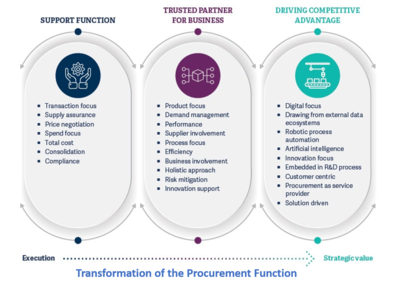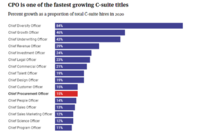Difference between revisions of "Chief Procurement Officer (CPO)"
| Line 37: | Line 37: | ||
[[Technology]] advancements have helped make that happen. Instead of the CPO being a mostly technical role, [[Artificial Intelligence (AI)|artificial intelligence]] and [[Machine Learning|machine learning]] have automated many rote procurement processes, such as vetting vendors and negotiating prices. That has allowed the CPO job to become a more a "qualitative or communication or a [[Leadership|leadership]] function," said Abe Eshkenazi, CEO of the Association for Supply Chain Management. It frees the CPO up to do risk-scenario planning, reduce total lifecycle and [[Total Cost of Ownership (TCO)|ownership costs]], and encourage [[Innovation|innovation]] in procurement and beyond. | [[Technology]] advancements have helped make that happen. Instead of the CPO being a mostly technical role, [[Artificial Intelligence (AI)|artificial intelligence]] and [[Machine Learning|machine learning]] have automated many rote procurement processes, such as vetting vendors and negotiating prices. That has allowed the CPO job to become a more a "qualitative or communication or a [[Leadership|leadership]] function," said Abe Eshkenazi, CEO of the Association for Supply Chain Management. It frees the CPO up to do risk-scenario planning, reduce total lifecycle and [[Total Cost of Ownership (TCO)|ownership costs]], and encourage [[Innovation|innovation]] in procurement and beyond. | ||
| + | |||
| + | |||
| + | ===See Also=== | ||
| + | [[Chief Executive Officer (CEO)]]<br /> | ||
| + | [[Chief Digital Officer (CDO)]]<br /> | ||
| + | [[Chief Financial Officer (CFO)]]<br /> | ||
| + | [[Chief Information Officer (CIO)]]<br /> | ||
| + | [[Chief Innovation Officer]]<br /> | ||
| + | [[Chief Marketing Officer (CMO)]]<br /> | ||
| + | [[Chief Operating Officer (COO)]]<br /> | ||
| + | [[Chief Risk Officer (CRO)]]<br /> | ||
| + | [[Chief Technology Officer (CTO)]]<br /> | ||
| + | [[C-Suite]]<br /> | ||
| + | [[Leadership]]<br /> | ||
| + | |||
| + | |||
| + | ===References=== | ||
| + | <references/> | ||
Revision as of 00:04, 29 April 2021
According to Business Dictionary, the Chief Procurement Officer, or CPO, is “[An] executive level employee whose responsibilities include sourcing, supply management, and procurement for the organization. Generally, the CPO reports directly to the Chief Executive Officer (CEO) of a company.”
And according to [Wikipedia], a CPO is, “typically the executive of a corporation who is responsible for the management, administration, and supervision of the company’s acquisition programs. They may be in charge of the contracting services and may manage the purchase of supplies, equipment, and materials.”
These definitions are both vague and redundant because the procurement industry lacks common definitions. Procurement is a business function focused on supply management, which by default includes sourcing – beyond day-to-day supplier management and transactional activity.
Ultimately, the procurement function is what develops and executes supply chain management processes, whether the resources used to perform the processes report to procurement or not. This means the CPO is the highest-ranking person in the company with the authority to influence the supply and the spending required to acquire the supply, throughout the entire company. The procurement policies and procedures determine which purchases require procurement’s input, and which ones are handled by end users. Generally, the purchasing department must play a role in any complex, long-term, or expensive purchases, while end users are allowed to handle one-off transactions that are simple and low cost.[1]
Evolving CPO Role: New Responsibilities and Opportunities[2]
As the CPO’s mandate continues to evolve and grow, CPOs will soon need new skills to match. The next generation of CPOs will be called upon for innovation, digitalization and to help steer the organization through volatility and complexity. They will continue to demonstrate strategic, innovative, determined and results-oriented leadership traits, as well as further develop their political savvy and influencing skills.
CPOs of the future need the skills to address the following areas:
- Innovation: The procurement function is becoming more strategic, and CPOs need to fill those bigger shoes. This means understanding the overall business drivers, having a longer-term view and innovating the way the function is running. Currently, the most common leadership traits in procurement are acting as a role model, collaborating internally and externally to deliver value and delivering results. Conversely, strategic leadership traits such as positive disruption, leading digital transformation and innovation are not commonly found among today’s CPOs but will need to be developed quickly.
“I’m out there looking for ways to keep improving and keep adding value. I spend 25% of my time there speaking with other CPOs, leaders from industry and technology companies, so I can find out how they’re thinking around these challenges and how they’re motivating their teams.” —Bob Murphy, CPO of IBM
- Building Ecosystems" Organizations can no longer afford to operate in isolation. Instead, they function as part of an enormous global network. CPOs must navigate a complex web of stakeholders, including suppliers, customers, internal colleagues, and external organizations and partners. The route to sustainable advantage lies in exploiting the strengths and competencies of various stakeholders to achieve greater responsiveness to market needs. As a result, best in-class CPOs have shifted to “systems thinking” and use their skills in relationship building and influencing to partner with suppliers and sometimes even competitors.
- Driving Sustainability and Understanding Risk Management: Today’s multinational organizations are part of multitiered global supply chains linked together in complex webs of relationships traversing multiple jurisdictions. These intricate networks can mask dangerous vulnerabilities: A problem in one area can quickly ripple up and down the supply chain, leading to severe reputational damage. Companies are also facing a growing number of regulations and an increased awareness among consumers around the sustainability of the goods they buy. Consumers and regulators today hold companies responsible not only for their own practices, but also for those of their suppliers. To meet their demands, CPOs must be prepared to increase transparency of the sustainability and compliance of their suppliers.
- Digital Advancement: While prospects of a digital transformation in procurement look promising, the reality is that most organizations have not yet captured the opportunities those tools will deliver. Procurement leaders need an understanding of how they can capture the benefits of those new tools for their own functions and across the organization. Beyond the procurement function, CPOs will increasingly be called upon to enable digital efforts across the organization, including honing an ability to source in-demand digital products like robotics and artificial intelligence.
- Future Ready Teams: Procurement leaders of the future will need to lead a different type of organization. New technologies could reshape what current procurement teams look like and how the procurement organization is structured. New roles are being introduced to the firm, and talent with an analytical or data science background is entering procurement teams. Unassisted, or cognitive, procurement holds the potential to also replace elements of traditional procurement teams.
Embracing the new direction of the CPO is no longer an option due to the competitive forces in every industry today. It is imperative for leaders to assess how they leverage the procurement function and where they are in terms of maturity of the function, as shown in the Figure below.
Technology Helps CPOs be more Strategic[3]
The role of the chief procurement officer is changing. According to LinkedIn Economic Graph Research, CPO ranks 11 on the list of fastest growing -C-Suite titles of 2020, with 15% growth (as a proportion of total C-suite hires last year). The need for more — and more critically thinking — CPOs is accelerating, said Pettis Kent, assistant professor of supply chain management at Loyola University Chicago Quinlan School of Business. That’s especially true for "multinational companies where they need someone to stand at the intersection between what we need internally and what’s available externally," he said. "The CPO is the man or woman who manages that entire organization." More strategy, collaboration, and perhaps diversity and inclusion lies ahead for this expanding, and increasingly important, role.
Traditionally, CPOs have had one job and one job only: drive down costs. They’ve largely been successful at that, said Alex Zhong, supply chain lead at IBM Sterling, and it can be seen especially in the lower cost of consumer goods. But forward-thinking CPOs have already moved past the bottom line and "saw that only focusing on cost is definitely not sufficient. They need to step up even more in a strategic position to really support the business growth from a revenue perspective," he said.
Technology advancements have helped make that happen. Instead of the CPO being a mostly technical role, artificial intelligence and machine learning have automated many rote procurement processes, such as vetting vendors and negotiating prices. That has allowed the CPO job to become a more a "qualitative or communication or a leadership function," said Abe Eshkenazi, CEO of the Association for Supply Chain Management. It frees the CPO up to do risk-scenario planning, reduce total lifecycle and ownership costs, and encourage innovation in procurement and beyond.
See Also
Chief Executive Officer (CEO)
Chief Digital Officer (CDO)
Chief Financial Officer (CFO)
Chief Information Officer (CIO)
Chief Innovation Officer
Chief Marketing Officer (CMO)
Chief Operating Officer (COO)
Chief Risk Officer (CRO)
Chief Technology Officer (CTO)
C-Suite
Leadership
References
- ↑ What & Who is a Chief Procurement Officer? Planergy
- ↑ Tomorrow’s CPO: New Responsibilities and Opportunities Russel Reynolds
- ↑ How Technology Helps CPOs be more Strategic Supply Chain Dive


